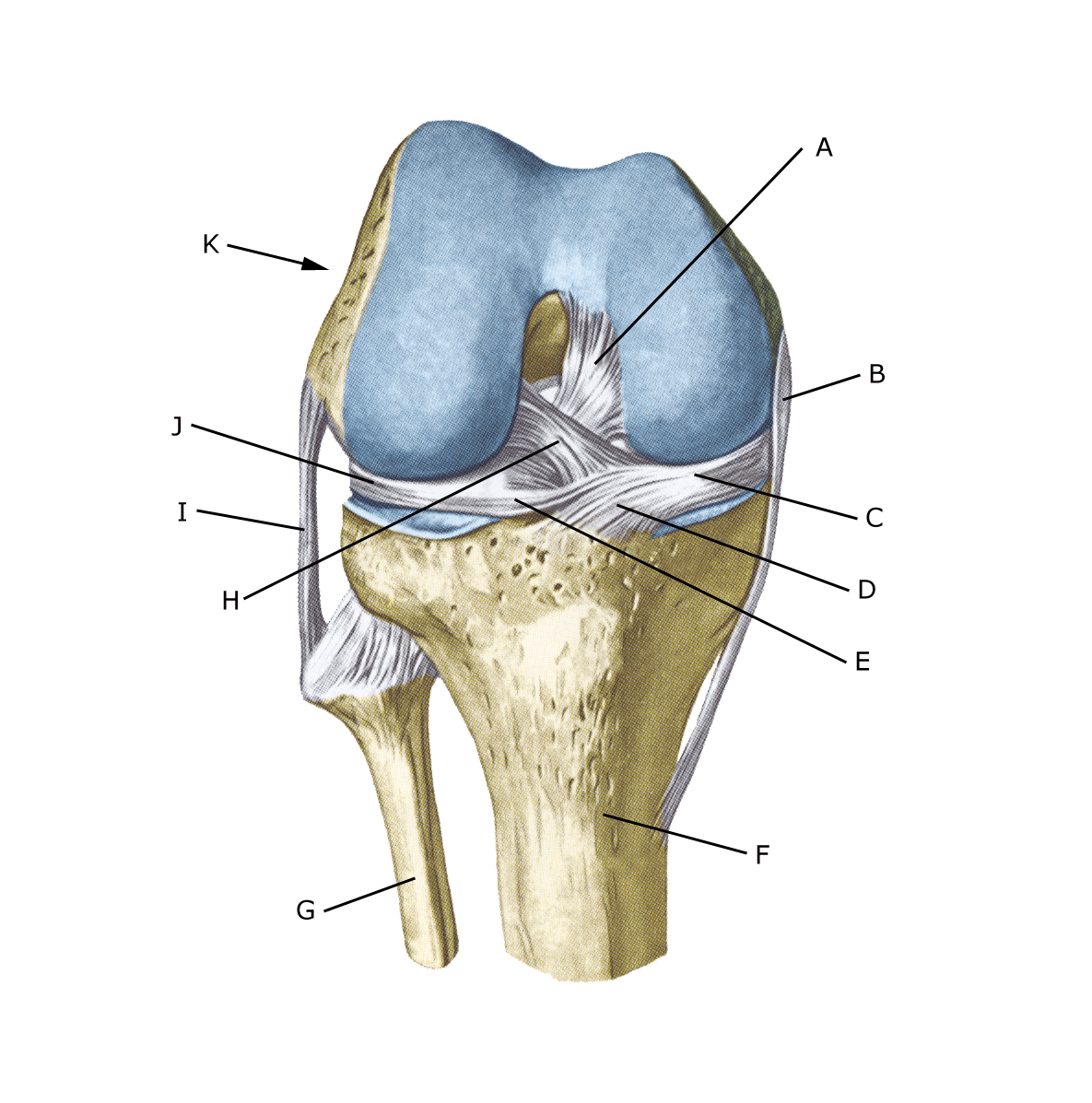Anatomy
The bones of the knee joint include the femur (thigh bone), tibia (shin bone) and patella (kneecap). There is also a small joint between the tibia and fibula (fibula). Inside the knee is an anterior and posterior cruciate ligament. The knee joint is reinforced by a joint capsule that is laterally reinforced with an external and an internal collateral ligament (ligamentum collaterale laterale (LCL) and ligamentum collaterale mediale (MCL), which, among other things, ensures the lateral stability of the knee. The lateral collateral ligament (LCL) attaches to the outside of the femur (lateral femoral condyle) and together with one of the hamstring muscles (biceps femoris) to the head of the fibula (caput fibula).
 Knee joint from the front:
Knee joint from the front:
A. Ligamentum cruciatum posterius
B. Ligamentum collaterale mediale/tibiale
C. Meniscus medialis
D. Insertio anterior menisci medialis
E. Ligamentum transversum genus
F. Tibiae
G. Fibulae
H. Ligamentum cruciatum anterius
I. Ligamentum collaterale laterale/fibulare
J. Meniscus lateralis
K. Femur
 Lower leg on the outside:
Lower leg on the outside:
A. Gastrocnemius muscle
B. Caput fibulae
C. B. subtendinea m. bicipitis femoris inferior
D. M. biceps femoris (overcut)
E. Ligamentum collaterale laterale/fibulare (outer lateral ligament)
F. M. plantaris
Cause
When the tibia is pressed outwards in relation to the femur (fibula, varus), the external collateral ligament is stretched. If the load is high enough (as is often the case if the load comes unprepared so that the thigh muscles do not have time to tense and stabilise the knee joint), the ligament can rupture.
Isolated rupture of the lateral collateral ligament is rare in children and adolescents and is almost always part of a more severe injury involving other structures in the knee (Davenport D, et al. 2018).
Symptoms
Sudden onset of pain on the outside of the knee. Sometimes a pop is felt when the ligament ruptures. In severe cases, the athlete complains of a feeling of looseness in the knee.
Examination
If total or partial rupture of the ligaments in the knee is suspected, a clinical examination should be performed by a relevant professional to ensure correct diagnosis and treatment. This includes assessing the extent of any other injuries.
The doctor can perform various stability tests on the knee. If the knee is stable, the injury is called a ‘sprain’ of the lateral collateral ligament. If the knee is loose, the injury is referred to as a ‘rupture’ of the ligament. If there is any doubt about the diagnosis, an ultrasound scan can be performed where the tear, possible bone tearing at the attachment and bleeding can be seen. See ultrasound scan.
MRI scans are indicated if other injuries are suspected, for example inside the knee.
Treatment
Treatment for total or partial tears of the lateral collateral ligament includes offloading and rehabilitation. A support splint (Don-Joy) can be used for a few weeks. There is no proven difference in outcomes between conservative and surgical treatment of isolated ACL tears in the knee (Davenport D, et al. 2018).
Most ruptures are treated without surgery. However, if there is pronounced looseness of the lateral collateral ligaments or if, as is often the case, the tear is combined with other knee injuries, surgery will often be indicated.
Bandage
A hinge bandage may be used for the first few weeks (Don-Joy). Tape treatment of lateral knee ligament ruptures is often used as a supplement to other rehabilitation treatments, although there is little evidence of effectiveness.
Complications
If no progress is made, you need to consider whether the diagnosis is correct.
In particular, the following should be considered:
- Meniscus lesion
- Outer collateral ligament rupture
- Rupture of the posterior cruciate ligament
- Cartilage damage in the joint
- Periosteal tears and fractures.
